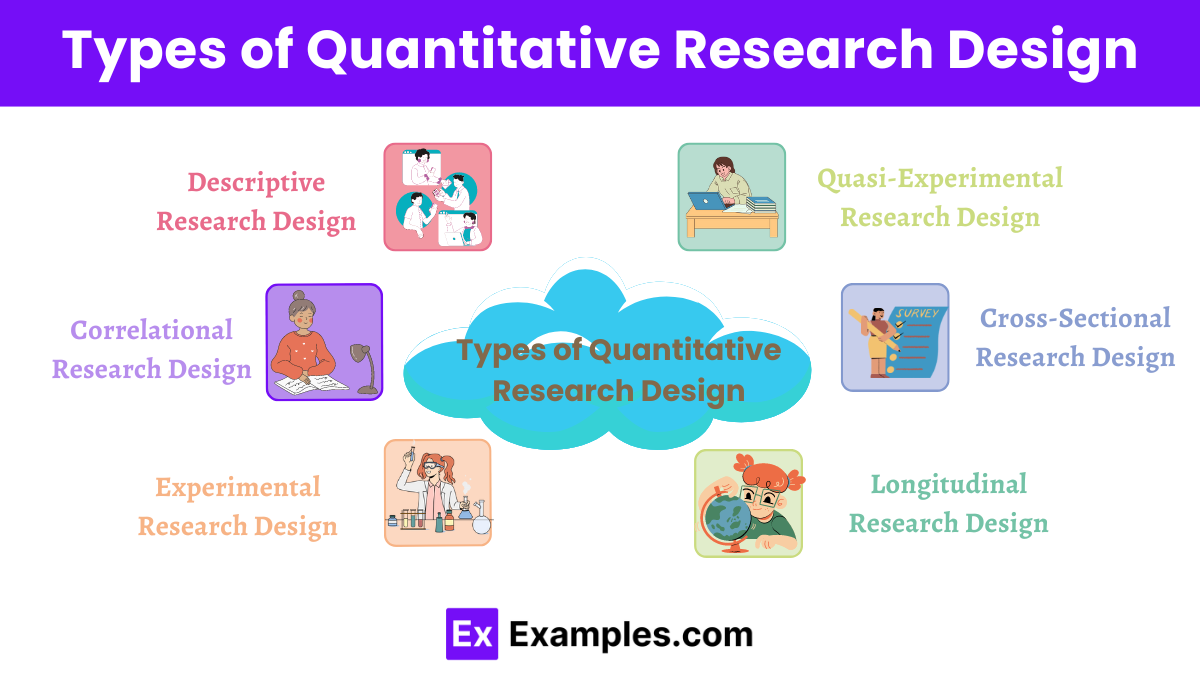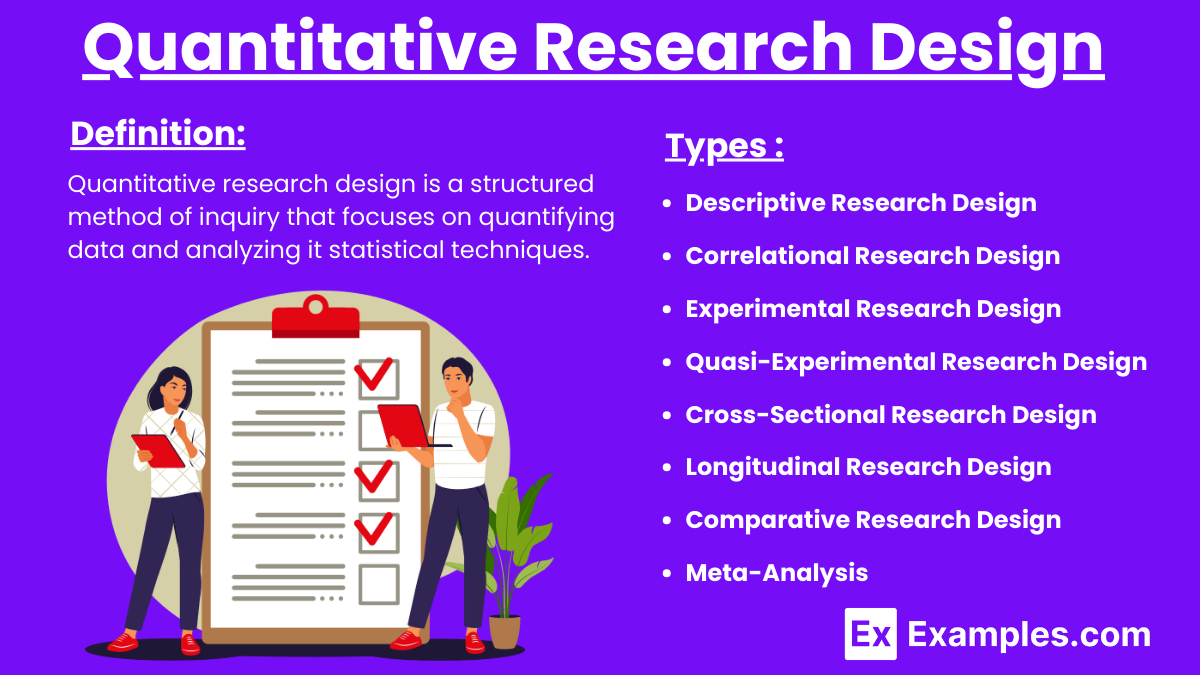Quantitative Research Design Examples
Quantitative research design is a systematic approach used to investigate phenomena by collecting and analyzing numerical data. It involves the use of structured tools such as surveys, experiments, and statistical analysis to quantify variables and identify patterns, relationships, and cause-and-effect dynamics. This Research design emphasizes objectivity and replicability, allowing researchers to generalize findings across larger populations. By focusing on measurable data, quantitative research design aims to provide precise and reliable results.
What is Quantitative Research Design?
Quantitative research design is a structured method of inquiry that focuses on quantifying data and analyzing it using statistical techniques. This approach involves collecting numerical data through various tools such as surveys, experiments, and questionnaires to identify patterns, relationships, and causal effects. The design emphasizes objectivity, allowing researchers to generalize findings to larger populations.
Types of Quantitative Research Design

1. Descriptive Research Design
- Purpose: To describe characteristics of a population or phenomenon.
- Methods: Surveys, observational studies, case studies.
- Example: Measuring the prevalence of a particular health behavior in a community.
2. Correlational Research Design
- Purpose: To identify and measure the relationship between two or more variables without manipulating them.
- Methods: Surveys, archival data analysis.
- Example: Examining the relationship between study habits and academic performance.
3. Experimental Research Design
- Purpose: To determine cause-and-effect relationships by manipulating one or more independent variables and measuring their effect on dependent variables.
- Methods: Randomized controlled trials, laboratory experiments.
- Example: Testing the efficacy of a new drug by randomly assigning participants to treatment and control groups.
4. Quasi-Experimental Research Design
- Purpose: To estimate causal relationships when random assignment is not possible.
- Methods: Non-randomized control groups, pre-test/post-test designs.
- Example: Evaluating the impact of an educational intervention in different schools where random assignment is not feasible.
5. Cross-Sectional Research Design
- Purpose: To collect data at a single point in time to provide a snapshot of a population or phenomenon.
- Methods: Census surveys, sample surveys.
- Example: Surveying a population to assess the current prevalence of smoking.
6. Longitudinal Research Design
- Purpose: To collect data from the same subjects over an extended period to observe changes and developments.
- Methods: Panel studies, cohort studies.
- Example: Following a group of students over several years to track their academic progress.
7. Comparative Research Design
- Purpose: To compare two or more groups or variables to identify similarities and differences.
- Methods: Case-control studies, cross-national studies.
- Example: Comparing educational outcomes between students from different countries.
8. Meta-Analysis
- Purpose: To combine data from multiple studies to draw more robust conclusions about a research question.
- Methods: Systematic reviews, statistical aggregation.
- Example: Aggregating data from various studies to assess the overall effectiveness of a particular therapy.
9. Secondary Data Analysis
- Purpose: To use existing datasets collected by other researchers or organizations to answer new research questions or test different hypotheses.
- Methods: Government surveys, social surveys, market research data.
- Example: Analyzing national health survey data to investigate trends in obesity rates.
10. Archival Research
- Purpose: To analyze existing data collected for purposes other than the current study to uncover long-term trends and patterns.
- Methods: Historical documents, government records, public databases.
- Example: Examining historical voting records to understand changes in political participation over time.
Quantitative Research Design Methods
1. Surveys
Surveys involve administering questionnaires or structured interviews to gather data from a sample of participants. Surveys can be implemented through different channels, such as conducting them in person, over the phone, via mail, or utilizing online platforms. Researchers use various question types, such as multiple-choice, Likert scales, or rating scales, to collect quantitative data on attitudes, opinions, behaviors, and demographics.
2. Experiments
Experiments involve manipulating one or more independent variables and measuring their effects on dependent variables. To compare outcomes, participants are assigned randomly to various groups, including control and experimental groups. Experimental designs allow researchers to establish cause-and-effect relationships by controlling for confounding factors.
3. Observational Studies
Observational studies involve systematically observing and recording behavior, events, or phenomena in natural settings. Researchers can use structured or unstructured quantitative observation methods, depending on the research objectives. Quantitative data can be collected by counting the frequency of specific behaviors or by using coding systems to categorize and analyze observed data.
4. Archival Research
Archival research involves analyzing existing data collected for purposes other than the current study. Researchers may use historical documents, government records, public databases, or organizational records to extract data through quantitative research. Archival research allows for large-scale data analysis and can provide insights into long-term trends and patterns.
5. Secondary Data Analysis
Similar to archival research, secondary data analysis involves using existing datasets that were collected by other researchers or organizations. Researchers analyze the data to answer new research questions or test different hypotheses. Secondary data sources can include government surveys, social surveys, or market research data.
6. Content Analysis
Content analysis is a method used to analyze textual or visual data to identify patterns, themes, or relationships. Researchers code and categorize the content of documents, interviews, articles, or media sources. The coded data is then quantified and statistically analyzed to draw conclusions. Content analysis can be both qualitative and quantitative, depending on the approach used.
7. Psychometric Testing
Psychometric testing involves the development and administration of tests or scales to measure psychological constructs, such as intelligence, personality traits, or attitudes. Researchers use statistical techniques to analyze the test data, such as factor analysis, reliability analysis, or item response theory.
Difference between Quantitative Research Design and Qualitative Research Design
| Aspect | Quantitative Research Design | Qualitative Research Design |
|---|---|---|
| Objective | To quantify variables and generalize findings from a sample to a population | To explore and understand meanings, experiences, and concepts |
| Data Type | Numerical data | Non-numerical data (text, images, etc.) |
| Research Methods | Surveys, experiments, observational studies, archival research, secondary data analysis, psychometric testing | Interviews, focus groups, participant observation, content analysis |
| Data Collection | Structured instruments like questionnaires, tests, or observation checklists | Unstructured or semi-structured techniques like open-ended interviews |
| Data Analysis | Statistical methods, mathematical models | Thematic analysis, coding, narrative analysis |
| Outcome | Objective, measurable results | Subjective insights, detailed descriptions |
| Sample Size | Large, representative samples | Small, purposive samples |
| Hypothesis Testing | Tests specific hypotheses | Generates hypotheses during the research process |
| Researcher Role | Detached and objective | Involved and subjective |
| Flexibility | Rigid and structured | Flexible and evolving |
| Validity and Reliability | High emphasis on reliability and validity through statistical measures | Emphasis on credibility, transferability, dependability, and confirmability |
| Generalizability | High, due to larger sample sizes and statistical analysis | Low, findings are specific to the context and participants studied |
| Examples of Research Methods | Randomized Controlled Trials (RCTs), longitudinal studies, cross-sectional surveys | Ethnographies, case studies, grounded theory studies |
How to Find Quantitative Research Design
Finding a quantitative research design involves several steps to ensure that the chosen method is suitable for your research question and objectives. Here’s a step-by-step guide:
1. Define Your Research Question
- Identify the Problem: Clearly define the problem or phenomenon you want to study.
- Specify Objectives: Determine what you aim to achieve with your research.
2. Literature Review
- Search Existing Research: Look for existing studies related to your topic in academic journals, books, and databases.
- Identify Gaps: Note any gaps in the current literature that your research could fill.
3. Choose a Suitable Research Design
- Descriptive Design: If your goal is to describe characteristics or functions, consider surveys or observational studies.
- Correlational Design: To explore relationships between variables, use correlational methods.
- Experimental Design: For establishing cause-and-effect relationships, conduct experiments with control and experimental groups.
- Quasi-Experimental Design: When random assignment isn’t feasible, use quasi-experimental designs.
- Longitudinal Design: If you need to study changes over time, choose a longitudinal approach.
- Cross-Sectional Design: For a snapshot of a population at a single point in time, use cross-sectional surveys.
4. Develop Your Hypothesis
- Formulate Hypotheses: Based on your research question, develop clear and testable hypotheses.
5. Select Your Sample
- Define the Population: Determine the population from which you will draw your sample.
- Sampling Methods: Choose an appropriate sampling method (random, stratified, cluster, etc.) to ensure representativeness.
6. Choose Data Collection Methods
- Surveys: Use questionnaires or structured interviews.
- Experiments: Design experiments with independent and dependent variables.
- Observations: Use structured or unstructured observation methods.
- Archival Research: Analyze existing records or databases.
- Secondary Data Analysis: Use pre-existing datasets for new analysis.
7. Design the Data Collection Instrument
- Create Surveys/Questionnaires: Develop questions that are clear and unbiased.
- Design Experimental Protocols: Outline the procedures for conducting experiments.
- Develop Observation Checklists: List specific behaviors or events to observe and record.
8. Pilot Testing
- Test Instruments: Conduct a pilot test to identify any issues with your data collection instruments or procedures.
- Refine Methods: Make necessary adjustments based on feedback from the pilot test.
9. Data Collection
- Implement Your Design: Collect data according to your chosen methods and protocols.
- Ensure Accuracy: Follow ethical guidelines and ensure accurate data recording.
10. Data Analysis
- Statistical Techniques: Use appropriate statistical methods to analyze your data.
- Software Tools: Utilize software such as SPSS, R, or Excel for data analysis.
FAQ’s
What is the purpose of quantitative research?
The purpose is to quantify variables, test hypotheses, and identify patterns, relationships, or causal effects through numerical data analysis.
What is a descriptive research design?
Descriptive research design aims to describe characteristics or functions of a population or phenomenon, without establishing cause-and-effect relationships.
What is correlational research design?
Correlational research design examines the relationship between two or more variables to determine if a connection exists, without implying causation.
What is causal-comparative research design?
Causal-comparative research design seeks to identify cause-and-effect relationships by comparing different groups based on varying independent variables.
What is an experimental research design?
Experimental research design involves manipulating one variable to determine its effect on another variable, establishing a cause-and-effect relationship.
What are independent and dependent variables?
Independent variables are manipulated to observe their effect on dependent variables, which are measured to see if they change due to the manipulation.
Why is random sampling important in quantitative research?
Random sampling ensures each member of a population has an equal chance of being selected, enhancing the generalizability of results.
What is the role of hypothesis in quantitative research?
A hypothesis is a testable prediction about the relationship between variables, guiding the direction and focus of the study.
What are common data collection methods in quantitative research?
Common methods include surveys, questionnaires, structured interviews, and standardized tests.
What is the significance of statistical analysis in quantitative research?
Statistical analysis helps interpret numerical data, identify trends, and test hypotheses, providing a basis for drawing conclusions.



